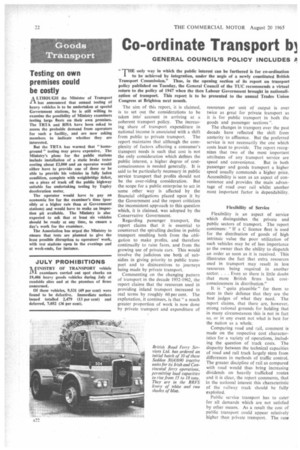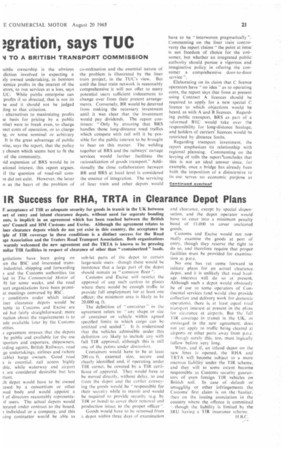Co-ordinate Transport b3 !gration, says TUC
Page 24

Page 25

If you've noticed an error in this article please click here to report it so we can fix it.
GENERAL COUNCIL'S POLICY INCLUDES 11 TO A BRITISH TRANSPORT COMMISSION THEonly way in which the public interest can be furthered is for co-ordination be achieved by integration, under the aegis of a newly constituted British Transport Commission." Thus, in the opening section of its report on transport policy published on Tuesday, the General Council of the TUC recommends a virtual return to the policy a 1947 when the then Labour Government brought in nationalization of transport. This report is to be presented to the annual Trades Union Congress at Brighton next month.
The aim of this report, it is claimed, is to set out the considerations to be taken into account in arriving at a coherent transport policy. The increasing share of transport expenditure in national income is associated with a shift from public to private transport. The report maintains that although the complexity of factors affecting a consumer's transport needs is such that cost is not the only consideration which defines the public interest, a higher degree of costconsciousness is needed generally. It is said to be particularly necessary in public service transport that profits should not be the over-riding consideration. But the scope for a public enterprise to act in some other way is affected by the financial obligations placed upon it by the Government and the report criticizes the inconsistent approach to this question which, it is claimed, was adopted by the Conservative Government.
Regarding passenger transport, the report claims that it is essential to counteract the spiralling decline in public transport resulting both from the obligation to make profits, and therefore continually to raise fares, and from the growing use of private cars. This would involve the judicious use both of subsidies in giving priority to public transport and to disincentives to journeys being made by private transport.
Commenting on the changing pattern of transport in the decade 1952-1962, the report claims that the resources used in providing inland transport increased in real terms by roughly 60 per cent. The explanation, it continues, is that "a much greater proportion of work is now done by private transport and expenditure of resources per unit of output is over twice as great for private transport as it is for public transport in both the goods and passenger sections".
The changes in transport over the past decade have reflected the shift from austerity to affluence. But the preferred service is not necessarily the one which costs least to provide. The report recognizes that two of the most important attributes of any transport service are
speed and convenience. But in both passenger and goods transport a higher speed usually commands a higher price. Accessibility is seen as an aspect of convenience and provides the main advantage of road over rail whilst another most important factor is dependability.
Flexibility of Service Flexibility is an aspect of service which distinguishes the private and public sectors of transport. The report continues: "If a C licence fleet is used for the distribution of goods of high intrinsic value the poor utilization of such vehicles may be of less importance to the owner than the ability to dispatch an order as soon as it is received. This illustrates the fact that extra resources used in transport may result in less resources being required in another sector. . . . Even so there is little doubt that most British firms lack costconsciousness in distribution."
It is "quite plausible" for them to state in their defence that they are the best judges of what they need. The report claims, that there are, however, strong rational grounds for holding that in many circumstances this is not in fact so, or in any event not what is best for the nation as a whole.
Comparing road and rail, comment is made on the respective cost characteristics for a variety of operations, including the question of track costs. The disparity between the technical capacities of road and rail track largely stem from differences in methods of traffic control. The greater discipline of rail as compared with road would thus bring increasing dividends on heavily trafficked routes and it is clear, the report comments, that in the national interest this characteristic of the railway track should be fully exploited.
Public service transport has to cater for all demands which are not satisfied by other means. As a result the cost of public transport could appear relatively higher than Ovate transport. The case
public ownership is the obvious diction involved in expecting a sly owned undertaking, in business ximize profits in the interest of the etors, to run services at a loss, says UC. While public enterprise can profits if so directed, that is not its se and it should not be judged ling to that criterion.
alternatives to maximizing profits te basis for pricing by a public orise) were to break even, to charge rect costs of operation, or to charge ig, or some nominal or arbitrary It is the great advantage of public rise, says the report, that the policy t chosen which seems best to fit the of the community.
)id expansion of BRS would be in ational interest, this report argues, if the question of road-rail cornin did not exist. However, the latter n as the heart of the problem of co-ordination and the essential nature of the problem is illustrated by the liner train project, in the TUC's view. But until the liner train network is reasonably comprehensive it will not offer to many potential users sufficient inducement to change over from their present arrangements. Conversely, BR would be deterred from making the necessary investment until it was clear that the investment would pay dividends. The report continues: "Only by ensuring that BRS handles those long-distance road traffics which compete with rail will it be possible for the public interest to be brought to bear on this matter. The welding together of BRS and the railways' cartage services would further facilitate the rationalization of goods transport." Additionally the close collaboration between BR and BRS at local level is considered the essence of integration. The servicing of liner train and other depots would
have to be "interwoven pragmatically ". Commenting on the liner train controversy the report claims "the point at issue" is not freedom of choice for the consumer, but whether an integrated public. authority should pursue a vigorous and imaginative policy in offering the consumer a comprehensive door-to-door service ".
Elaborating on its claim that C licence operators have "no idea "as to operating costs, the report says that firms at present using Contract A licences should he required to apply for a new special C licence to which objections would be heard as with A and B licences. Regarding public transport, BRS as part of a reformed BTC would take over the responsibility for long-distance haulage, and holders of carriers' licences would he restricted by distance limits.
Regarding transport investment, the report emphasizes its relationship with regional planning. Commenting on the levying of tolls the report4concludes that this is not an ideal answer since, for example, once a bridge has already been built the imposition of a disincentive to its use serves no economic purpose as
Continued overleaf




















































































































